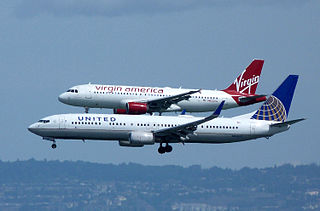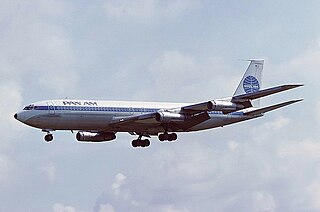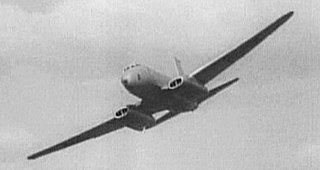Related Research Articles

An airliner is a type of aircraft for transporting passengers and air cargo. Such aircraft are most often operated by airlines. Although the definition of an airliner can vary from country to country, an airliner is typically defined as an airplane intended for carrying multiple passengers or cargo in commercial service. The largest of them are wide-body jets which are also called twin-aisle because they generally have two separate aisles running from the front to the back of the passenger cabin. These are usually used for long-haul flights between airline hubs and major cities. A smaller, more common class of airliners is the narrow-body or single-aisle. These are generally used for short to medium-distance flights with fewer passengers than their wide-body counterparts.

The Boeing 707 is an American, long-range, narrow-body airliner, the first jetliner developed and produced by Boeing Commercial Airplanes. Developed from the Boeing 367-80 prototype first flown in 1954, the initial 707-120 first flew on December 20, 1957. Pan Am began regular 707 service on October 26, 1958. With versions produced until 1979, the 707 was a swept wing, quadjet with podded engines. Its larger fuselage cross-section allowed six-abreast economy seating, retained in the later 720, 727, 737, and 757 models.

The Boeing 727 is an American narrow-body airliner that was developed and produced by Boeing Commercial Airplanes. After the heavier 707 quad-jet was introduced in 1958, Boeing addressed the demand for shorter flight lengths from smaller airports. On December 5, 1960, the 727 was launched with 40 orders each from United Airlines and Eastern Air Lines. The first 727-100 rolled out on November 27, 1962, first flew on February 9, 1963, and entered service with Eastern on February 1, 1964.

The de Havilland DH.106 Comet was the world's first commercial jet airliner. Developed and manufactured by de Havilland in the United Kingdom, the Comet 1 prototype first flew in 1949. It featured an aerodynamically clean design with four de Havilland Ghost turbojet engines buried in the wing roots, a pressurised cabin, and large windows. For the era, it offered a relatively quiet, comfortable passenger cabin and was commercially promising at its debut in 1952.

The de Havilland Aircraft Company Limited was a British aviation manufacturer established in late 1920 by Geoffrey de Havilland at Stag Lane Aerodrome Edgware on the outskirts of north London. Operations were later moved to Hatfield in Hertfordshire.
Hamburger Flugzeugbau (HFB) was an aircraft manufacturer, located primarily in the Finkenwerder quarter of Hamburg, Germany. Established in 1933 as an offshoot of Blohm & Voss shipbuilders, it later became an operating division within its parent company and was known as Abteilung Flugzeugbau der Schiffswerft Blohm & Voss from 1937 until it ceased operation at the end of World War II. In the postwar period it was revived as an independent company under its original name and subsequently joined several consortia before being merged to form Messerschmitt-Bölkow-Blohm (MBB). It participates in the present day Airbus and European aerospace programs.

A jet airliner or jetliner is an airliner powered by jet engines. Airliners usually have two or four jet engines; three-engined designs were popular in the 1970s but are less common today. Airliners are commonly classified as either the large wide-body aircraft, medium narrow-body aircraft and smaller regional jet.

The Sud Aviation SE 210 Caravelle is a French jet airliner produced by Sud Aviation. It was developed by SNCASE in the early 1950s, and made its maiden flight on May 27, 1955. It included some de Havilland designs and components developed for the de Havilland Comet. SNCASE merged into the larger Sud Aviation conglomerate before the aircraft entered revenue service on April 26, 1959, with Scandinavian Airlines System (SAS); 282 were built until production ended in 1972. It was ordered by airlines on every continent and operated until its retirement in 2005.

The HFB 320 Hansa Jet is a twin-engine, ten-seat business jet that was designed and produced by German aircraft manufacturer Hamburger Flugzeugbau between 1964 and 1973. The most recognisable and unconventional feature of the aircraft is its forward-swept wing.

The Rolls-Royce Spey is a low-bypass turbofan engine originally designed and manufactured by Rolls-Royce that has been in widespread service for over 40 years. A co-development version of the Spey between Rolls-Royce and Allison in the 1960s is the Allison TF41.

The Boeing 367-80, known simply as the Dash 80, is an American quadjet prototype aircraft built by Boeing to demonstrate the advantages of jet propulsion for commercial aviation. It served as basis for the design of the KC-135 tanker and the 707 airliner.

The Avro 706 Ashton was a British prototype jet airliner made by Avro during the 1950s. Although it flew nearly a year after the de Havilland Comet, it represented an experimental programme and was never intended for commercial use.

The Hawker Siddeley HS-121 Trident is a British airliner produced by Hawker Siddeley. In 1957, de Havilland proposed its DH.121 trijet design to a British European Airways (BEA) request. By 1960, de Havilland had been acquired by Hawker Siddeley. The Trident's maiden flight happened on 9 January 1962, and it was introduced on 1 April 1964, two months after its main competitor, the Boeing 727. By the end of the programme in 1978, 117 Tridents had been produced. The Trident was withdrawn from service in 1995.

The Arsenal VG 70 was a single-seat monoplane research aircraft flown in France shortly after World War II to assist in the development of high-speed jet fighters. Lacking an indigenous turbojet engine, the aircraft was fitted with a German Junkers Jumo 004. Unlike most jet-powered aircraft of the period, the swept wing was wooden as was the tail structure. The under-powered VG 70 made its maiden flight in 1948, but only flew five times before the program was terminated the following year.
The Vickers-Armstrongs V-1000 was a proposed jet-powered cargo aircraft that was designed to meet a requirement issued by the British Ministry of Supply which sought a strategic transport for the Royal Air Force (RAF) to support its strategic bomber fleet, particularly the V-bombers. The design bears many similarities to the Vickers Valiant, one of the V-bombers, but also featured substantial changes. In addition to its military application, both the Ministry and Vickers also intended to use the same basic design as the VC7, a six-abreast trans-Atlantic jet airliner for British Overseas Airways Corporation (BOAC).

The Rolls-Royce RB.162 is a lightweight British turbojet engine produced by Rolls-Royce Limited. Developed in the early 1960s, it was specially designed for use as a lift engine for VTOL aircraft but was also used in a later variant of the Hawker Siddeley Trident airliner as an auxiliary boost engine. A smaller related variant, the RB.181 remained a design project only, as did a turbofan version designated RB.175.

The Rolls-Royce RB.141 Medway was a large low-bypass turbofan engine designed, manufactured and tested in prototype form by Rolls-Royce in the early-1960s. The project was cancelled due to changes in market requirements that also led to the development and production of the smaller but similar Rolls-Royce Spey, and the cancellation of the Armstrong Whitworth AW.681 military transport aircraft project.

The Bristol Type 200 was a proposal for a short-range aircraft by the Bristol Aeroplane Company in 1956. Although it was designed in response to a specification issued by British European Airways (BEA), the Type 200 was larger than the airline's requirements and was closer to the Boeing 727 in size and range. The project was cancelled when BEA selected the Hawker Siddeley Trident instead. The Trident went on to have a production run of 117, while the 727 had a production run of over 1800. Along with the Vickers V-1000, it is seen by some as one of the great "what ifs" of British aviation, although it never got beyond the drawing board.
The Hamburger Flugzeugbau HFB 209 was a postwar design project for a twin-turboprop medium-range transport.

The IA 36 Cóndor was a projected Argentine jet propelled mid-range airliner, designed in the early 1950s by Kurt Tank for the “Fábrica Militar de Aviones”. It was cancelled in 1958, with no prototypes built, but a full size wood mockup.